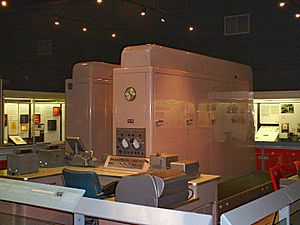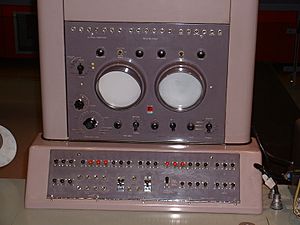Ferranti Pegasus facts for kids
The Pegasus was an early British computer built by a company called Ferranti. It was special because it used "vacuum tubes" (like old light bulbs) and was designed to be easier for people to use. It was first called the Ferranti Package Computer because it was built with parts that could be easily plugged in, like building blocks.

Three main people helped create it: W. S. (Bill) Elliott (for the parts), Christopher Strachey (for the programs), and Bernard Swann (who helped sell it). The Pegasus was Ferranti's most popular computer of its kind, with 38 sold. The first Pegasus was delivered in 1956, and the last one in 1959. A group called the National Research Development Corporation (NRDC) helped pay for its creation.
Today, at least two Pegasus computers still exist. One is at The Science Museum, London. The other was at the Science and Industry Museum, Manchester, but it is now in storage. The Pegasus in the London Science Museum ran its first program in December 1959. It was shown to the public regularly until 2009, when it had a big electrical problem. In 2014, the Science Museum decided to stop using it permanently. This ended the life of one of the world's oldest working computers. The Pegasus was officially the world's oldest computer until 2012. That's when the Harwell computer was fixed up at the National Museum of Computing.
How the Pegasus Computer Was Designed
In the early days of computers, it was often hard to tell if a problem was with the computer's parts or with its program. Because of this, Christopher Strachey from the NRDC, who was a very smart programmer, suggested some important design goals for the Pegasus:
- It should be easy to program. Programmers shouldn't have to spend too much time making their code super-efficient.
- The computer's instructions should be chosen to help programmers.
- The computer should be cheap and reliable.
The first goal was partly met. The computer's main memory could only hold 128 "words" (pieces of data). The rest of the information was stored on a spinning "magnetic drum." This meant programmers often had to be clever to move data between the fast main memory and the slower drum.
The Pegasus had eight "accumulators." These are like special storage spots for numbers. Seven of them could also be used as "index registers," which help the computer find data. This was the first computer to allow this dual use. Each "word" of data had 39 bits, plus one extra bit for checking errors. Two instructions could be packed into one word. There was an extra bit that could make the computer pause, which helped find mistakes in programs.
The Pegasus was quite fast for its time. It could add numbers in about 128 microseconds (a microsecond is one-millionth of a second). Other operations like multiplying took longer. Moving data to and from the magnetic drum was done in a planned way. The computer was advertised as weighing about 1,160 kilograms (2,560 pounds).
The third goal, being cheap and reliable, was also mostly met. A Pegasus 1 cost about £50,000. This price did not include things like magnetic tape drives or a printer. However, its design, with parts that could be plugged in, made it very reliable. It was also easy to fix.
What Pegasus Computers Were Used For
The first version of Pegasus, called Pegasus 1, was made for science and engineering work. It took information from paper tape and printed results onto tape. A different version, Pegasus 2, was made for business. It could use punched cards, magnetic tape, and a line printer.
In 1956, the first Pegasus was used to figure out the stresses on the tail of an airplane called the Saunders-Roe SR.53. The results were used to check the manufacturer's own calculations. Because computers were so important, this first Pegasus was kept in a fancy drawing room in Ferranti's London office.
A Pegasus 1 was also set up in Sheffield for a company called United Steel. It was the first computer used there for "management cybernetics," which is about using systems thinking to manage organizations.
The Pegasus at Southampton University was used to analyze data for a helicopter called the Saro P.531. This helicopter later became the Westland Scout and Westland Wasp.
In 1957, a Pegasus computer was used to calculate 7,480 digits of the number Pi. This was a record at the time! In 1959, an aviation company called Handley Page Ltd was looking for experienced Pegasus programmers to join their team.
The University of Leeds also had a Pegasus computer, run by Sandy Douglas. It was used for many things, including processing the university's student records.
Other people who worked on the Pegasus included Hugh McGregor Ross and Donald B. Gillies.
See also
- List of vacuum-tube computers



